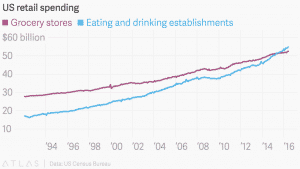
Good article by Elliot Maras published last week regarding jobs and the fast food kiosk.
By now you’ve already heard it — the introduction of self-order restaurant kiosks is raising fears that kiosks are killing jobs. News media outlets and websites are perpetuating the story that restaurants want to replace workers with kiosks to protect their bottom lines.
What’s to be done about it? Plenty.
If ever there were a time for the kiosk industry to speak with a collective voice, that time is now. Let’s start with a reality check.
Restaurants in the fast casual space have deployed tablets on the tables for years now. Those kiosks have increased the spend and added efficiencies. They have helped increase business and traffic flow. Customers complete surveys and provide feedback. E-Club enrollments. Customers and businesses are very happy with these kiosks. Notables in this “fast casual” space are Chili’s, Paneras and Red Robin.
The restaurants have grown and prospered. Kitchens have been upgraded for more capacity, and more people have been employed. One industry insider says:
In a dozen years of providing self order kiosks to the restaurant industry, I haven’t seen a reduction in “total labor”. In many cases the order taking (and less frequently payment) is automated, but more orders are processed and the orders are larger. That means more labor is needed in the kitchen and customer service. It really is more of a shift that a reduction.
Drive-thru and outdoor ordering have been mainstays for kiosks/ordering stations, and we are seeing next generation touchscreen ordering from companies like NEXTEP and many others. Tommy Woycik of NEXTEP insight:
When we introduced self order at the drive thru, many restaurants that had closed their drive thrus were able to reopen them. Without the automation, the economics simply didn’t make sense (i.e. the drive thru was losing money). Closing the drive thru eliminated a job. Reopening with a kiosk actually added labor, but just enough to make the drive thru feasible.
As far as the economic circumstance consider what the investment Seeking Alpha site has to say —
The restaurant industry can be difficult to navigate as food trends shift like the wind. Companies that operate a large number of locations should produce significant margins from size and scale. However, because the consumer can be fickle when it comes to eating out, margins and revenue can quickly turn south as volume slips from over extension, saturation, or just a change in diet. Restaurants need foot traffic, automobile access, or a consistent supply of guests like a hotel or resort. Because of this and other equipment requirements, restaurant leases are amongst some of the highest cost in the country. The reason for this is simple: Location. Location. Location.
Margins in a franchisee business, especially in low-cost fast food like a McDonalds or Burger King or Subway are tough adversaries.
Still, Americans are spending more at bars and restaurants than at grocery stores for the first time ever. $55B versus $53B according to Quartz report.
Fast Food Kiosk Coming Up Fast?
Recently we have seen the McDonalds announcement where, having done most of Europe, it is now looking to introduce self-ordering in the United States.
The CEO of CKE Andy Puzder, who has been a tireless opponent of minimum wage over the years, is now conveying the sense that kiosks are a result of minimum wage coming with a bit of “I told you so” for effect.
We have seen very few deployments in fast food and we won’t see significant minimum wage increases for several years. The franchisee model and the type of food service may be more relevant factors.
Self-service arrived many years ago and is simply expanding given the increased connectivity and independence of those customers. And the battle for new customers and most importantly retaining your current customers.
| More Jobs – consider the jobs that automation supports. From basic metal fabrication, design, concierge, assistants, service techs, admins and yes, even, salespeople which we sometimes make fun of. They all support families and communities.
Automation creates a ton of jobs all the way across the food chain (so to speak) from metal fabricators, engineers, service techs, salespeople and many many more. How many jobs does automated checkout at Walmart account for at NCR? Tens of thousands. Panera’s is a great example of modern thinking in the food industry. How many jobs does Amazon and Bezos create, foster and necessitate? Those automation jobs in the warehouses (even with the automation) count. |
And before we assign the entire industry to McDonalds/CKE/Darden/YUM/JackintheBox/Wendys, consider this quote from thebalance.com:
Even though it seems like the largest U.S. restaurant chains dominate the retail restaurant niche, only about 30% of America’s restaurants are part of a multi-unit chain, and only a fraction of those restaurant chains are publicly traded restaurant companies. The vast majority of U.S. retail diners are spending $1.9 billion in approximately one million restaurant locations owned by individual culinary entrepreneurs.”
For contrast consider the early theory that ATMs will eliminate bank employees. Banks became smaller for sure but they built more of them, and more people were employed.
So What Does Kill Jobs If Anything?
The statements that kiosks are killing jobs are more targeted at killing minimum wage politically. That’s politics and those issues come and go as it serves someones interests. You might also say China is killing jobs too, but it’s not really them that is killing jobs.
The tax advantages of imported goods may go away in a new “border adjustable” Republican plan (which companies like Walmart are not happy with). Incentivising companies to build in the US will create jobs.
A labor shortage for skilled workers and craftsmen (higher middle class) is killing jobs. People need to be trained. See Profoundly Disconnected and Mike Rowe which we support.
Fact is though Automation and connectivity are killing jobs.
Mr. Maras makes the good point that training and skilled workers is a fundamental issue. Vocational schools which focus on job skills with computers and automation. And why not take a page from the German labour playbook? Works for their labour force.
From the Wall Street Journal:
Other countries devote more resources than the U.S. to cushioning and retraining displaced workers. As a share of gross domestic product, Denmark spends 25 times as much, says Dr. Autor.
He offers another historical example. Near the end of the 19th century, America’s agricultural states faced the prospect of mass unemployment as farms automated.
In response, they created the “high school movement,” which required everyone to stay in school until age 16. It was hugely expensive, both because of the new schools and teachers, but also because these young people could no longer work on the farm. But it better prepared workers for 20th century factory jobs and fueled the explosion in college attendance after World War II.
Self-service automation is energizing the job market and the general economy. The clear benefits will not go away and by implementing them properly businesses will be enabled to indeed grow to the next level, and even more people will be employed.
Amazon says it will create 100,000 jobs in U.S. by 2018
Amazon will create 100,000 full-time jobs in the United States with full benefits over the next 18 months, the tech giant announced in a statement Thursday.
The company says the positions are for workers across the country and across all skill and experience levels. Most of the positions will be at fulfillment centers, including new ones under construction in California, Florida, New Jersey and Texas.
“Innovation is one of our guiding principles at Amazon, and it’s created hundreds of thousands of American jobs,” said Amazon founder and CEO Jeff Bezos in a statement. “These jobs are not just in our Seattle headquarters or in Silicon Valley—they’re in our customer service network, fulfillment centers and other facilities in local communities throughout the country.”
Kiosk Industry Association
Followup: One of the KI sponsors (Olea) contributed this — We’ve been following Mike Rowe of Dirty Jobs fame and he’s doing a lot to promote this sort of thing. Our thought was to create a foundation that starts with say a $5k scholarship or money to a school who’s got a great set of shop classes, or one that is building a shop class and is short on funds. We think we could get suppliers and other companies that we work with to also support our efforts to take that number higher over the years. Companies that we buy CNC equipment from or grinder belts those types of vendors.
Comments:
When we purchased a new press brake for $300k Amada the manufacturer told us that it had all sorts of software on it to make running it easier. Then we got it and found out you really needed very qualified operators at +$50k salary. We had to use 3 agencies to find two people and we offered a signing bonus, 1 week vacation and 75% company paid HMO. It took us months to find people.
A year or so later we had a conversation with them and they said it’s not something that is taught anywhere. You get on the job training and build up to it. So, we have a program here to teach anyone that wants to learn. Then Amada said they’ve been forced to figure out how to make the machines smarter so that anyone can run them. In exchange, you’ll get anyone to run the machine for $15 bucks an hour but why??? All because nobody is being trained to do these things. Businesses will adapt. Labor shortages and training is causing higher level middle class jobs to disappear just as fast or faster than innovation or anything else.
Then of course there’s China or other places with low labor costs causing havoc. Everyone pays the same price for a high-end CNC machine no matter where you are in the world. But the guy standing at the machine for a few bucks an hour vs. the guy making $26 per hour makes it tough for America to compete. Hence the US Kiosk industry needing to be very fast with custom designed goods that can be built and delivered before a Chinese box can be put on a boat for a 4-6 week journey.
Members involved in Self-Service and this article.




